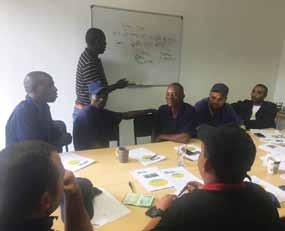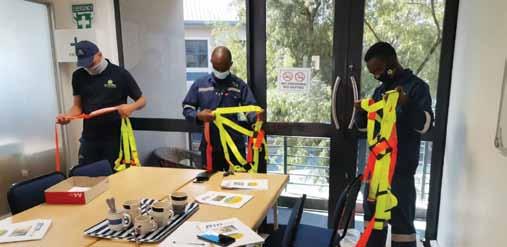
4 minute read
Training materials
and construction, and the to operate the on-site equipment,” says ross.
NOViCES AND REFRESHERS
Advertisement
“To train a novice to become a licensed concrete pump operator takes five days, and as with all training that involves vehicles and equipment it expires after two years and has to be renewed with a refresher course, including an eye test and medical certificate – given that workers age. This is important because the workers may not use the equipment regularly, but perhaps only every three or six months when their firm wins a specific type of contract. We do find that people coming for their refresher have not seen that equipment for two years and have forgotten how it functions,” says ross.
Furthermore, they have to do the refresher within 90 days of the expiry of the two-year license period or either redo the full five-day course as a novice, or a rPl (recognition of Prior learning) three-day course.
“We buy the specific SAQA training books and materials from the Transport Seta (TETA) which covers the sector of driven machinery. This is to enable us to be accredited to do the training and get moderated and also audited by TETA to check our training system and materials. This is important because there are many unaccredited or even fly-by-night training programmes on the market using out of date manuals which are not updated to the new regulations and unit standards. These operators get business by being cheaper, and they are cheaper through not being accredited or appropriate.
“In every case, we deliver the training at the client’s premises or on site wherever it is in the country, as this enables us to show them how to operate the machine they will actually be using in situ. We do not run a traditional college whereby learners come to our classrooms except in some cases where clients have small numbers of learners, and it becomes more cost effective in that instance than sending our trainer to their premises. on driven machinery we are only permitted to train four at a time and the training needs to take place where the machinery is.”
Drivers of concrete mixers for instance are limited to the tonnage size of their vehicle and cannot drive a larger tonnage mixer because they function differently.
A further complication is that mines are big employers and are governed by a separate set of rules in the Mines Act, and much of the training Akane does on concrete pumping takes place on mines. In this instance, it is a combination of the unit standard, the operating manual for the equipment and is also site specific to the mine, incorporating their site procedures.
“The occupational Health and Safety Act is actually written ‘with blood’, developed from all the workplace safety incidents that have occurred over the years. When someone has died on site, it makes regulators think about how to avoid such incidents, and this is how the Act has been crafted over time. This has resulted in regulations having a zero tolerance towards safety – it always comes first. It never used to be like that, and has only evolved since 2009, which is when I became involved in training. Safety was always important, but zero tolerance was not,” explains ross. Today, there are much fewer workplace incidents.
being trained – at least through rPl – also enhances individual worker’s career prospects. ross explains that they often find someone who has been doing a certain job for ten years without any formal qualification. Through their three-day rPl courses that person gets a formal qualification which makes them more marketable – as opposed to having to prove they can do the job each time they get employed.
TRAiL OF ACCOuNTABiLiTy
ross explains the trail of accountability: under section 16.1 of the oHS the director is accountable for health, safety and training and can be imprisoned for certain breaches. The director in turn commonly delegates that accountability under section 16.2 to a manager who is required to ensure all workers are appropriately trained. The training provider in turn is also accountable, says ross, and if there is an incident the training provider will also be investigated.
“For this reason it is imperative we keep our records in excellent order documenting that the training was done according to regulations, with IDs, eye tests, driver’s license and more - and that we are accredited.” often, says ross, she is called in by a client which is ignorant of even what training they require, and it is her job to inform them of their legal obligations in respect of training and oHS. “For example, a Working at Heights need is itself quite vast, there are many different types of courses. It is similar to consulting. To answer their need I require a full understanding of what the project entails and what exact work they will be doing, or I might suggest the wrong training – and that invokes my accountability. This becomes an issue for companies that undercut on the tender simply in order to win it, don’t do the appropriate needs-based research and thereafter suggest inappropriate courses. The client might not know what to ask and are not getting advised appropriately.
“We do a fair bit of training outside South Africa’s borders especially in Mozambique, DrC and Malawi, and to a lesser extent in Swaziland and botswana. because their oHS regulations are often weak we train them according to the South African oHS legislation.” These countries tend to be far behind the curve when it comes to oHS and ross says it is only South African companies in such countries that follow regulations and train their workers, because even abroad South African companies have to follow South African regulations. They would get their local contract companies to follow suit, says ross. n











